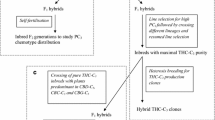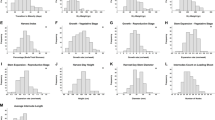Abstract
A genetic factor that blocks the cannabinoid biosynthesis in Cannabis sativa has been investigated. Crosses between cannabinoid-free material and high content, pharmaceutical clones were performed. F1s were uniform and had cannabinoid contents much lower than the mean parental value. Inbred F2 progenies segregated into discrete groups: a cannabinoid-free chemotype, a chemotype with relatively low cannabinoid content and one with relatively high content, in a monogenic 1:2:1 ratio. In our model the cannabinoid knockout factor is indicated as a recessive allele o, situated at locus O, which segregates independently from previously presented chemotype loci. The genotype o/o underlies the cannabinoid-free chemotype, O/o is expressed as an intermediate, low content chemotype, and O/O is the genotype of the high content chemotype. The data suggests that locus O governs a reaction in the pathway towards the phenolic cannabinoid precursors. The composition of terpenoids and various other compound classes of cannabinoid-free segregants remains unaffected. Backcrossing produced cannabinoid-free homologues of pharmaceutical production clones with potential applications in pharmacological research. A new variant of the previously presented allele ‘B 0’, that almost completely obstructs the conversion of CBG into CBD, was also selected from the source population of the cannabinoid knockout factor.




Similar content being viewed by others
References
Anonymous (1996) Nouvelles variétés de lins et chanvre. Semences et Progres 96:110–111
Appendino G, Gibbons S, Giana A, Pagani A, Grassi G, Stavri M, Smith E, Rahman MM (2008) Antibacterial cannabinoids from Cannabis sativa: a structure-activity study. J Nat Prod 71:1427–1430. doi:10.1021/np8002673
de Meijer EPM, Hammond KM (2005) The inheritance of chemical phenotype in Cannabis sativa L. (II): cannabigerol predominant plants. Euphytica 145:189–198. doi:10.1007/s10681-005-1164-8
de Meijer EPM, Bagatta M, Carboni A, Crucitti P, Moliterni VMC, Ranalli P, Mandolino G (2003) The inheritance of chemical phenotype in Cannabis sativa L. Genetics 163:335–346
de Meijer EPM, Hammond KM, Micheler M (2009) The inheritance of chemical phenotype in Cannabis sativa L. (III): variation in cannabichromene proportion. Euphytica 165:293–311. doi:10.1007/s10681-008-9787-1
Fellermeier M, Zenk MH (1998) Prenylation of olivetolate by a hemp transferase yields cannabigerolic acid, the precursor of tetrahydrocannabinol. FEBS Lett 427:283–285. doi:10.1016/S0014-5793(98)00450-5
Fellermeier M, Eisenreich W, Bacher A, Zenk MH (2001) Biosynthesis of cannabinoids, incorporation experiments with 13C-labeled glucoses. Eur J Biochem 268:1596–1604. doi:10.1046/j.1432-1327.2001.02030.x
Gorshkova LM, Senchenko GI, Virovets VG (1988) Method of evaluating hemp plants for content of cannabinoid compounds [Russian]. Referativnyi Zhurnal 12.65.322
Hillig KW (2002) Letter to the editor. JIH 7:5–6
Mandolino G (2004) Again on the nature of inheritance of chemotype. JIH 9:5–7
Morimoto S, Komatsu K, Taura F, Shoyama Y (1997) Enzymological evidence for cannabichromenic acid biosynthesis. J Nat Prod 60:854–857. doi:10.1021/np970210y
Morimoto S, Komatsu K, Taura F, Shoyama Y (1998) Purification and characterization of cannabichromenic acid synthase from Cannabis sativa. Phytochemistry 49:1525–1529. doi:10.1016/S0031-9422(98)00278-7
Morimoto S, Tanaka Y, Sasaki K, Tanaka H, Fukamizu T, Shoyama Y, Shoyama Y, Taura F (2007) Identification and characterization of cannabinoids that induce cell death through mitochondrial permeability transistion in Cannabis leaf cells. J Biol Chem 282:20739–20751. doi:10.1074/jbc.M700133200
Pacifico D, Miselli F, Micheler M, Carboni A, Ranalli P, Mandolino G (2006) Genetics and marker-assisted selection of the chemotype in Cannabis sativa L. Mol Breed 17:257–268. doi:10.1007/s11032-005-5681-x
Pate DW (1998) The phytochemistry of Cannabis: its ecological and evolutionary implications. In: Ranalli P (ed) Advances in hemp research. The Haworth Press, New York, pp 21–42
Raharjo TJ, Chang WT, Verberne MC, Peltenburg-Looman AMG, Linthorst HJM, Verpoorte R (2004a) Cloning and over-expression of a cDNA encoding a polyketide synthase from Cannabis sativa. Plant Physiol Biochem 42:291–297. doi:10.1016/j.plaphy.2004.02.011
Raharjo TJ, Chang WT, Choi YH, Peltenburg-Looman AMG, Verpoorte R (2004b) Olivetol as a product of a polyketide synthase in Cannabis sativa L. Plant Sci 166:381–385. doi:10.1016/j.plantsci.2003.09.027
Samuelsson G (1999) Drugs of natural origin, 4th edn. Swedisch Pharmaceutical Press, Stockholm, p 551
Shoyama Y, Hirano H, Nishioka I (1984) Biosynthesis of propyl cannabinoid acid and its biosynthetic relationship with pentyl and methyl cannabinoid acids. Phytochemistry 23:1909–1912. doi:10.1016/S0031-9422(00)84939-0
Sirikantaramas S, Taura F, Tanaka Y, Ishikawa Y, Morimoto S, Shoyama Y (2005) Tetrahydrocannabinolic acid synthase, the enzyme controlling marijuana psychoactivity, is secreted into the storage cavity of the glandular trichomes. Plant Cell Physiol 46:1578–1582. doi:10.1093/pcp/pci166
Sytnik VP, Stelmah AF (1999) The character of inheritance of differences in cannabinoid content in hemp (Cannabis sativa L). J Int Hemp Association 6:8–9
Taura F, Morimoto S, Shoyama Y, Mechoulam R (1995) First direct evidence for the mechanism of delta-1-tetrahydrocannabinolic acid biosynthesis. J Am Chem Soc 38:9766–9767. doi:10.1021/ja00143a024
Taura F, Morimoto S, Shoyama Y (1996) Purification and characterization of cannabidiolic-acid synthase from Cannabis sativa L. J Biol Chem 271:17411–17416. doi:10.1074/jbc.271.29.17411
Virovets VG (1996) Selection for non-psychoactive hemp varieties (Cannabis sativa L.) in the CIS (former USSR). J Int Hemp Assoc 3:13–15
Virovets VG (1998) Interview. J Int Hemp Assoc 5:32–34
Virovets VG, Senchenko GI, Gorshkova LM, Sashko MM (1991) Narcotic activity of Cannabis sativa L and prospects of its selection for decreased content of cannabinoids. Agric Biol 1:35–49 Russian
Virovets VG, Scherban I, Orlov N (1997) Selektion auf niedrige Gehalt der Cannabinoid und hohe Produktivität im Schaffungsprogramm von Hanfsorten (Cannabis sativa L.), die keine narkotische Ativität besitzen. Proceedings of the symposium Bioresource Hemp 97, Frankfurt am Main, pp135–153
Acknowledgments
We thank Mirta Micheler, James Amos and Andrew Bracking for the chemical comparison of segregant bulks.
Author information
Authors and Affiliations
Corresponding author
Rights and permissions
About this article
Cite this article
de Meijer, E.P.M., Hammond, K.M. & Sutton, A. The inheritance of chemical phenotype in Cannabis sativa L. (IV): cannabinoid-free plants. Euphytica 168, 95–112 (2009). https://doi.org/10.1007/s10681-009-9894-7
Received:
Accepted:
Published:
Issue Date:
DOI: https://doi.org/10.1007/s10681-009-9894-7




